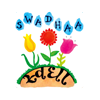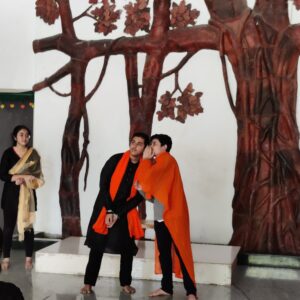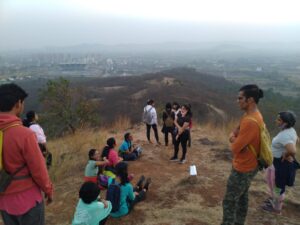)
The primary task through these years is to educate and nourish the imaginative powers of the child.
It is this vital picture making capacity that gives life and insight to logical and conceptual thinking
– Dr.Rudolf Steiner
A distinguishing characteristic of the Waldorf curriculum across all grades is the Block teaching through Main Lesson.
After the morning academic work comes the artistic, practical and movement classes, as well as continuing work in English, mathematics and other languages.
Besides language arts, science, math and history Swadhaa also offers specialty subjects as per specific grades:
Handwork: knitting, crochet, sewing, cross-stitch, basic weaving, toy making
Woodworking
Music: singing, pentatonic flute, recorder, string instruments, wind, brass, and percussion instruments.
Languages: Hindi, Marathi, Sanskrit.
Art: watercolor painting, form drawing, beeswax and clay modeling, perspective drawing.
Games
To provide security and continuity in the passage from childhood to adolescence, a dedicated group of teachers oversee the students’ development between the ages of 7 to 14. In this way the teachers are aware of each student in depth and carefully can attend to his or her needs over time.
The 1st grade curriculum is built on daily routines that provide form, structure and rhythm for independent work and group activities. A first grader is introduced to the letters of the alphabet through oral storytelling and chalkboard drawings, it is about bringing consciousness to the richness of the language. The teachers lead the children from concrete representational pictures to abstract letter symbols.
The first grader experiences the curriculum through natural sciences, fairy tales, handwork, music, painting, form drawing and clay modeling.
First Grade Curriculum:
By second grade, children become increasingly aware of their experiences in the larger world and the values and perspectives of others. In written work and rhythmic movement exercises, students practice mastering the times and division tables as well as advanced addition and subtraction processes including transferring and place value. Form drawing (creating simple geometric shapes) is taught to bring balance and control to handwork and prepare the children for cursive writing. These challenging exercises develop the child’s cognitive ability and flexible thinking.The children make a great leap from First to Second Grade. The world of Fairy Tales, although not completely absent, now makes way for the Lives of the Saints, biographies of men and women with an historical verity and fables. The Fables point out the foibles suddenly appearing all over; the Saints’ legends calm, console and reassure.They mirror the soul qualities which are present in human beings. . Fables are not as much about animals but about the animal qualities human beings have inside them. The fables and animal tales thus allow children to identify with the instinctive animal qualities inside them. Writing, which was virtually an extension of drawing in Grade One, now stands on its own.
Second Grade Curriculum:
In third grade the child experiences a new sense of self. Students begin to question, “Who am I in relation to others and to the world?’ In Waldorf education we recognize this stage of self-discovery as the nine-year change. New capacities for thinking and judgment are emerging. The younger child’s experience of the unity of all things matures into the third grader’s awareness of a distinctly separate inner life. Strong opinions, likes and dislikes are emerging. The children begin to develop a more realistic view of everyone and everything around them.
Children are now ready to learn more about the outside world. In this process of becoming self-aware, Steiner suggested telling the children stories that involve separation, followed by a good outcome where all is well again.
“In the beginning God created the heaven and the earth…” and with these mighty words, begins, Grade Three’s journey.
Creation Myths with imaginative and magical pictures are told to children to describe the beginnings of life on earth. These creation stories give the children a reverence for their place in creation and particularly the human race. The experiences of the characters of these stories that are told live so deeply in the souls of the children that any moral becomes self-evident.
Third Grade Curriculum:
Fourth graders become more self-confident as their perceptions of the world sharpen. They also experience a stronger separation from their surroundings and become more independent. These developmental steps broaden the child’s perspective and show a world of endless, exciting possibilities. The fourth grader has an adventurous spirit, is full of curiosity, and is eager to explore new capacities for learning and creativity.
In 4th grade, the world-which once exhibited a magical wholeness begins to break apart. This is the appropriate time to introduce fractions. Through hands-on activities, the children find a world of numbers in between any two whole numbers. In geography, they start learning about local geography. It is difficult to separate the Geography and History of a local area and often it makes sense to combine them: first emphasising the land and its physical features, followed by the people who lived there or who created the history of the place. So they get more connected to the land and the people. Hence, experiencing the “wholeness” of life and how we all belong together on the earth.In science, the children learn about animals’ diverse qualities and contrast them to human capacities. The students learn research skills and do their first independent report on an animal of their choice. They also advanced writing skills with book reports.
Fourth Grade Curriculum:
Fifth grade is referred to as the “golden year” because students at this age are enthusiastic about learning, eager for new challenges and capable of hard work and creativity. A sense of self-consciousness emerges, yet they remain confident and harmonious with their surroundings. They develop an ordered sense of space and time, and hold a deeper understanding of personal responsibility and the ethics of right and wrong.
In fifth grade, students begin the exploration of the world in ever-widening circles of time and space. They still have openness to the world, and a level of confidence that makes them easy to teach. In geography, they study the regional and physical geography of their country or larger region. In history, they meet the ancient civilizations of India, Persia, Egypt and Greece through the study of mythology and culture. Plant life is the focus of science, and decimals are introduced in the mathematical lessons. Instrumental music, singing and artistic studies continue and woodworking is introduced.
Fifth Grade Curriculum:
In sixth grade, the curriculum focuses on the children’s growing orientation towards the outer world. As new capacities for thinking emerge, the children are led to understand causal relationships at work in the world. The students can be challenged and are capable of high standards in their school work. The sixth grade curriculum serves to ground the students, to inspire them to venture out toward the unknown and to offer an introduction to their quest in life. In mathematics, students learn the exact constructions with compass and straightedge, learning the mathematical properties of shapes as well as simple formulas. Physics is introduced through art and music. Roman law, black and white drawings, gymnastic exercises designed to model how one overcomes obstacles, skills to “compare and contrast” and astronomy are also introduced into the curriculum at this time.
Sixth Grade Curriculum:
Seventh graders navigate two worlds: they inhabit an introspective side as well as an active, outer, exploring perspective. At this age they have a growing need for independence and solitude; they feel enhanced emotional sensitivity and experience a strong need for social connection. Their adolescence is marked by many physical, emotional and cognitive changes including energetic outbursts, and a motivating desire for exploration alternating with periods of emotional listlessness or increased self absorption.
The seventh grade block curriculum studies the Renaissance, the Age of Exploration, the Scientific Revolution and the Reformation in order to activate the students’ developing engagement with and questioning in the world. The students study the innovative thinkers of these eras whose thirst for knowledge was coupled with a fearless need to question and defy authority. The class teacher guides the students in projects that enable them to take an active role in the outer world. They respect and nurture the student’s inner emotional lives while simultaneously challenging their cognitive and creative skills.
Seventh Grade Curriculum:
A Waldorf eighth grade experiences a gradual but significant shift from the presentation of a subject solely from the teacher to the class, to the mutual consideration of a subject by teacher and class together. A sense of community develops in which speaking becomes more thoughtful and listening more attentive. With the awakening capacity for logical thinking and free, independent judgment, the eighth grader now wants to be in the world more than ever before. They want to do, to discover, to know, and to find relevance in their studies by finding connections with the outside world.
Throughout this year, the students continue to expand their sense of place in the world. They plunge into the Age of Revolution, and embark on a study of noteworthy individuals who have found the courage to follow their passions in revolt against the status quo. In addition to their continued inquiry into scientific phenomena and experimentation, students study the lives and struggles of scientists and inventors who first discovered chemical and electrical laws. These studies ground students in the human aspect of scientific thought, while providing a picture of the profound effects of modern technology upon society and culture.
Eighth Grade Curriculum:
The eighth grade year marks the students’ final year with their Class Teacher, and culminates in the completion of their Waldorf grade school experience. Given the huge step these students are about to take in the world, the curriculum is designed to inspire passion and highlight the incredible potential of the human mind and soul. It is our hope that our students will graduate with compelling questions that will continue to fuel their love of learning for years to come.
Young adolescents now reach a developmental stage where their inner life of feeling can take extreme forms in their search for independence. The age is characterised by:
They need the guidance of strong ideals to orient their strong will to engage on life. Class 9 & 10 children need to be handled with clear explanations, sympathetic understanding and open hearted humor from all adults around them.
Curriculum:
From Grade 9 onwards children transition to IGCSE curriculum.
Biology (0610)
Cambridge IGCSE Biology helps learners to understand the biological world in which they live and take an informed interest in science and scientific developments. The syllabus includes the basic principles and concepts that are fundamental to the subject, some current applications of biology, and a strong emphasis on practical skills.
Mathematics
(0580)
Chemistry
(0620)
Physics
(0625)
English as Second Language
(0510/0511)
Hindi – Elective
(0549)
Sanskrit
(0599)

Children at this age are highly motivated and also become aware of the social renewal that is needed in the community around them. Harnessing these energies through connecting with communities that are working towards a more inclusive and a better society for tomorrow, children at Swadhaa work consistently with organisations like Sagar mitra and Sadhana Village a haven for specially abled adults.

“Tell me and I forget, teach me and I may remember, involve me and I learn”
~ Benjamin Franklin
Children visit various professions ad companies as part of learning Sciences. Karigiri, Sugar factory (Daund) etc to name a few.

Their art lessons involve painting and drawing especially in black and white, the play between light and dark – which reflects a stage in life that they go through.
They also explore some Indian folk arts like Madhubani, Palm leaf painting, Linocut, along with portrait and landscape paintings.

Handwork of all kinds – woodwork, textiles, clothes, leather, paper crafts, basket work, ceramic and metal work etc. involving an element of designing form a part of their curriculum.

Singing & making music together is socially and therapeutically important at this age. Children engage in in singing together and making music together. This is integrated in their regular curriculum.

Children have sessions with Mentors and Mindfulness practitioners to delve deeper in questions that they have about life, people, relationships, beliefs, customs and everything that they experience.

Cultivating a calm inner self, a healthy body and mind is emphasized at Swadhaa. Children practice yoga, meditation and are are initiated in kriyas which bring alignment and integration of the whole human being.

Drama is an important component for learning at Swadhaa. In higher grades, children learn character development through drama. Children work with theatre specialists in honing their skills in this art and put up a presentation of their work.

Journaling is an exercise that has been introduced for middle grades and we go much deeper in higher grades. Guided by the teacher, journaling helps students to connect with themselves which is very necessary, especially for 15, 16 years old.

Children travel for outdoor study camps as an extension of their syllabi. They also go out for treks and nature walks

Indian philosophy is marked by its unflinching devotion to search for truth. This spirit led to the formation of method of philosophical discussion which is brought to children to introduce to them disciplines of thought and the criteria of right thinking. Hence, children are introduced to the Darshan Shastras of India.